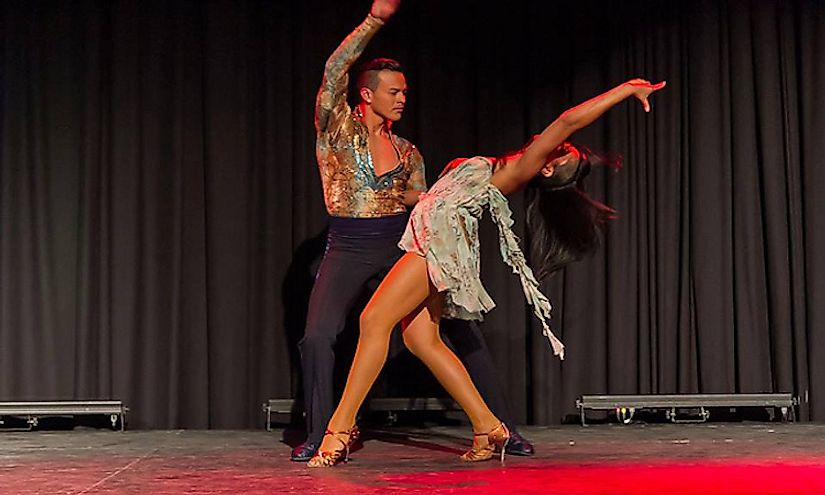Not known Incorrect Statements About Dance San Francisco
Table of ContentsThe Of Dance San FranciscoThe Buzz on Dance San FranciscoThe smart Trick of Dance San Francisco That Nobody is DiscussingGetting The Dance San Francisco To WorkIndicators on Dance San Francisco You Need To KnowFascination About Dance San FranciscoSome Ideas on Dance San Francisco You Need To Know
The significant distinction that differentiates the Miami-style from other North American styles is the "Atras" or "Diagonal", back breaking actions executed in reverse diagonally rather than relocating forwards and backwards as seen in the New york city style. Professional dancers do not shift their body weight considerably as seen in other designs. bay area salsa dancing. Rather, dancers maintain their top body still, positioned and loosened up, concentrating on foot activityA major distinction between Cali Design and Miami-style is the last is solely danced on the downbeat (On1) and has components of lusters and show-style added to it, adhering to arsenals of North American styles. Miami-style has numerous followers, especially Cuban-Americans and other Latinos based in South Florida.
Many of the moves involve swiftly exchanging companions. "Rueda de Miami" come from in the 1980s from Miami, is a formal design with several regulations based on a mix, and is a hybridization of Rueda de Cuba & North American dancing styles, with some routines reflecting American culture (e
Coca-Cola, Dedo, Adios) which is not found in discovered traditional Cuban-style Typical. Cali is also recognized as the "Funding de la Salsa" (Salsa's Capital); due to salsa songs being the major category in parties, bars and celebrations in the 21st century.
The elements of Cali-Style Salsa were highly influenced by dancings to Caribbean rhythms which preceded salsa, such as Pachanga and Boogaloo. Cali has the greatest variety of salsa institutions and salsa teams on the planet. Much of the competitions are kept in Colombia. The main function is the footwork which has quick fast steps and missing movements called "repique".
A Biased View of Dance San Francisco
They consist of numerous acrobats such as partnered turns to amuse with these jaw going down feats. Their footwork is complex and specific, helping a number of Colombian Design professional dancers win major world championships. Cali hosts numerous yearly salsa occasions such as the Globe Salsa Cali Festival and the Encuentro de Melomanos y Coleccionistas.
Researchers in the natural sciences researched the math of salsa dancing relocations. In the social scientific researches, researchers have actually researched salsa dance to comprehend, for instance how the Latino identity is linked to salsa dancing. The research study this content of salsa dancing has been examined as a allegory to recognize emotional and cultural economic climates.
Centro Journal. Retrieved 2023-05-26. Salsa Vida.
Salsa Vida. 26 June 2023. Gotten 5 October 2023.
Salsa Vida. Movers and Shakers Salsa & Bachata Dancing Academy. Spinning Mambo Into Salsa.
Gotten 2019-06-26. Waxer, Lise Aerinne (2002 ). The city of musical memory: salsa, record grooves, and pop culture in Cali, Colombia. Music/culture. Middletown, Conn: Wesleyan College Press. ISBN 978-0-8195-6441-2. " Colombian Design Salsa". Salsa Vida SF. Gotten 27 July 2020. von Renesse, Christine; Ecke, Volker (2011-03-01). " Mathematics and Salsa dancing". Journal of Mathematics and the Arts.

Dance San Francisco Can Be Fun For Anyone
:10. 1002/cb. Journal of Service Research Study.

Something went incorrect. Wait a moment and attempt once more Attempt again.
A Biased View of Dance San Francisco
We're speaking about the dancing, not the delicious South American spice. The origins of words "Salsa" as the name of a dance has actually been a resource of discussion for decades. The most popular (and possibly approved) concept is that Cuban and Puerto Rican artists in New York created the expression in New york city in the 1970's, to explain the spicy combination of music they were creating out of the rhythms and motifs of Cuban boy montuno, guaracha, chachacha, mambo and bolero.